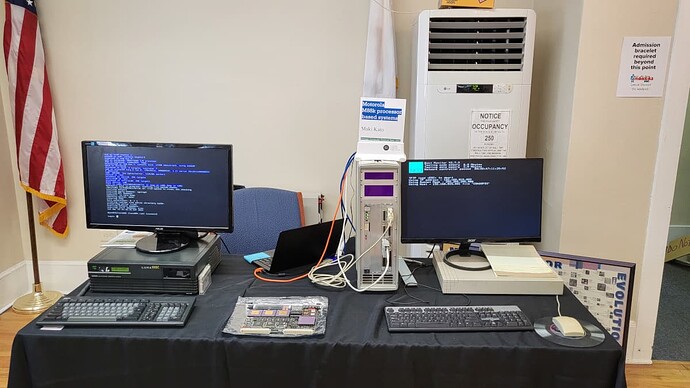Here’s Maki Kato’s setup from last year’s VCF-E in New Jersey:
I had an Omron Luna 88k running OpenBSD 7.2 and a MVME-187C running Sys/V 88k. A laptop running OpenBSD-luna on an emulator called nono and a NCD-88k xTerm that didn’t boot.
Subsequent adventures as seen on their blog:
- Tektronix XD88 - Part 1
- Hello World on the NCD XTerm
- Getting started on Ghidra Processor module for m88k
Ghidra is an amazing open source reverse engineering tool. Of course it doesn’t support the m88k yet, but it’s architected in a way that allows processors to be added via a plug-in mechanism. So, I’ve decided to try coding up the m88k so that I can use Ghidra to disassemble the NCD roms and Xterm image
Following links we find a page on OMRON’s LUNA 88k workstation - archived version is better because we can follow links to old news articles.
- OMRON in Uncle Miod’s machineroom
1989 press release:
Omron Tateishi Electronics is pitching its new Luna-88K Motorola 88000 RISC-based workstations, due to be available in March, at the university market, and has priced them at the same level as less powerful machines from competitors: the Luna-88K comes with up to four 88000 RISC processors and runs under Carnegie Mellon University’s Mach variant of Unix: the station comes with 16Mb main memory, 250Mb disk and a black and white display, and prices start at a daunting $20,550; 88000-based systems are already in the market from Nippon Data General and Sony Tektronix.
From 1990:
The Luna/88K uses four 33MHz 88000 RISC processors, is rated at 100 MIPS and will cost around $50,000. Again it runs the Mach operating system, comes with X Window System, Motif, TCP/IP and Network File System, and will be out at the end of the year.
More pics of the Luna 88k linked here.
